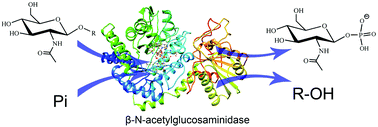Insights into the catalytic mechanism of N-acetylglucosaminidase glycoside hydrolase from Bacillus subtilis: a QM/MM study†
Abstract
The peptidoglycan (PG) metabolic process is essential for bacterial growth. β-N-Acetylglucosaminidases (NagZ enzymes) are involved in the PG process and they catalyze the removal of terminal N-acetylglucosamine in PG fragments. According to the amino acid sequence and secondary structures, NagZ enzymes should belong to the glycoside hydrolase family GH3. However, a recent experimental study revealed that NagZ enzymes are glycoside phosphorylases rather than glycoside hydrolases. To further understand the catalytic process of NagZs at the atomistic level, the reaction mechanism of NagZ from Bacillus subtilis (BsNagZ) has been studied by using a QM/MM approach. Our calculation results show that the glycosylation of the substrate is the rate limiting step of the whole catalytic cycle with an energy barrier of 19.3 kcal mol−1, which is close to the free energy barrier (16.4 kcal mol−1) estimated from the experimental rate constant. For deglycosylation, both the hydrolysis and phosphorylation of the glycosyl-enzyme intermediate were explored. The phosphorylation corresponds to the lower energy barrier than hydrolysis (1.8 vs. 17.7 kcal mol−1), giving theoretical support to the previously suggested phosphorylase activity of NagZ enzymes. In both the glycosylation and deglycosylation steps, the oxocarbenium-ion-like transition states are always involved, and the substrate distortion in the active site can significantly facilitate the reaction, in which residue D123 plays a key role in this distortion. This is the first computational report for understanding the phosphorylase activity of NagZ enzymes.


 Please wait while we load your content...
Please wait while we load your content...